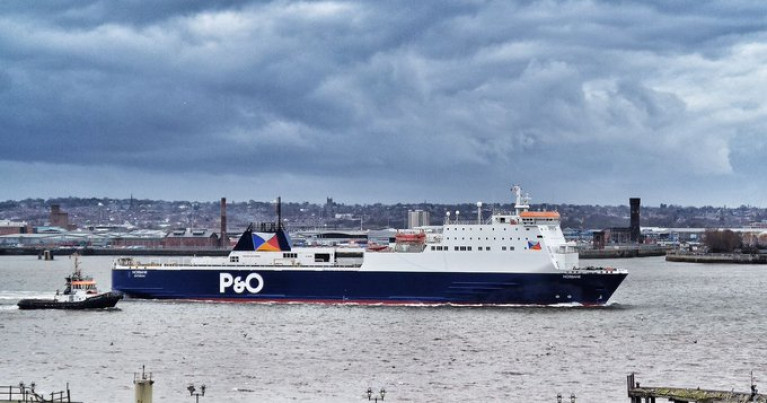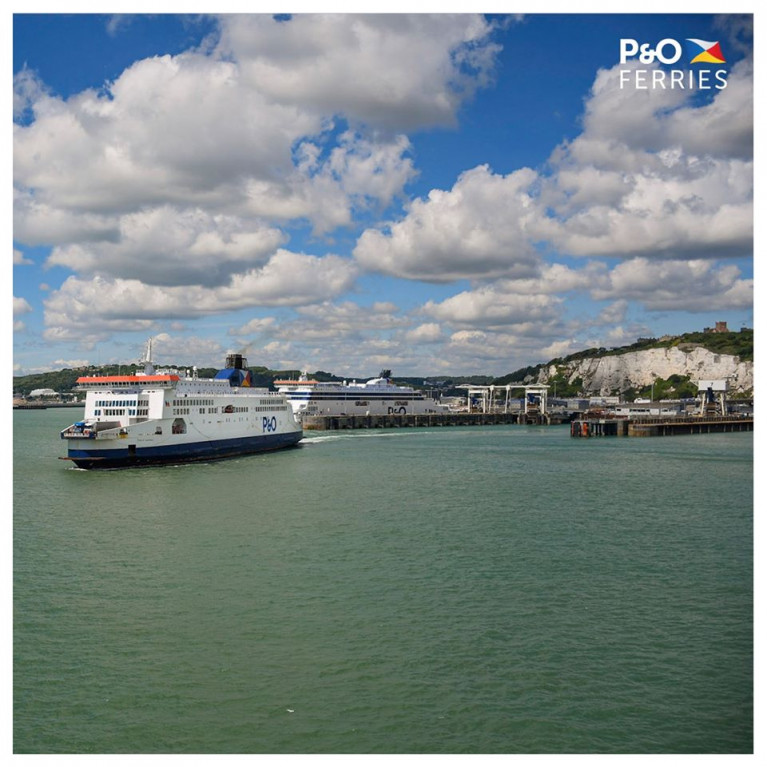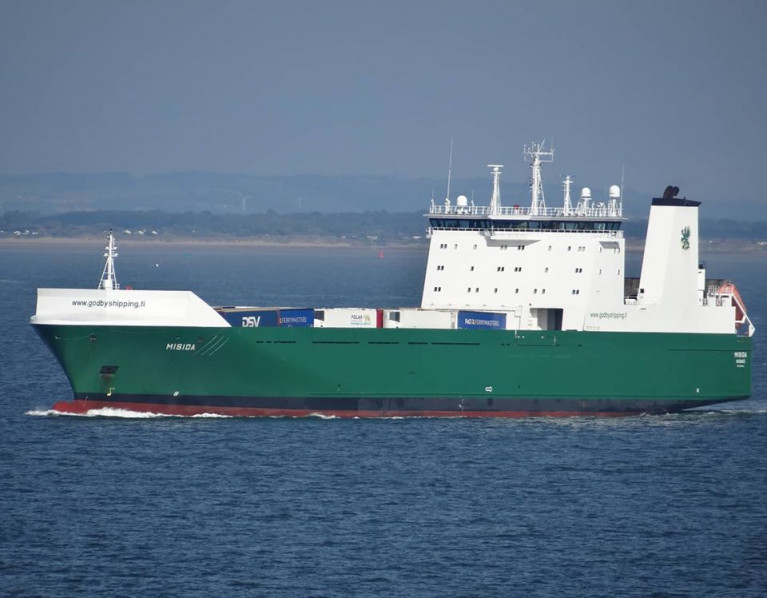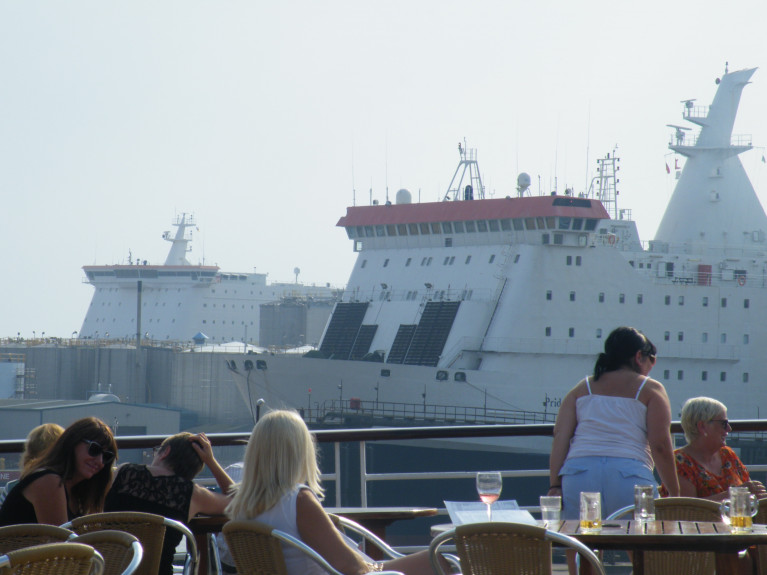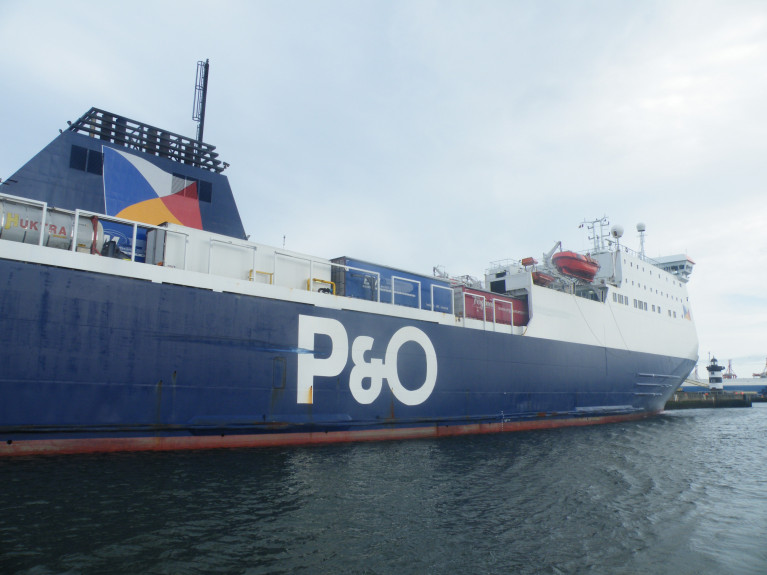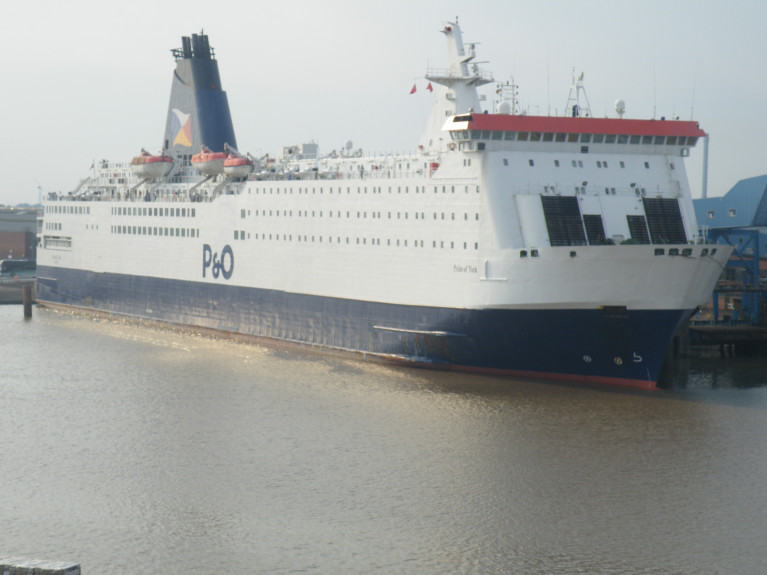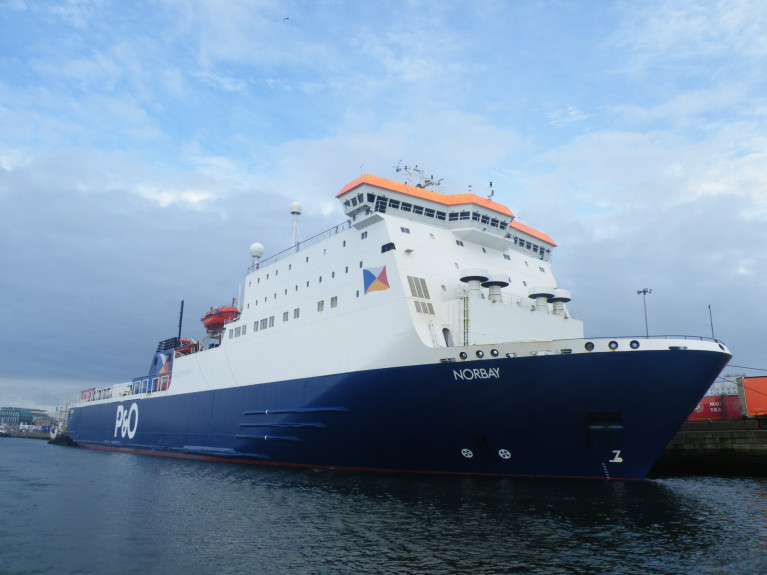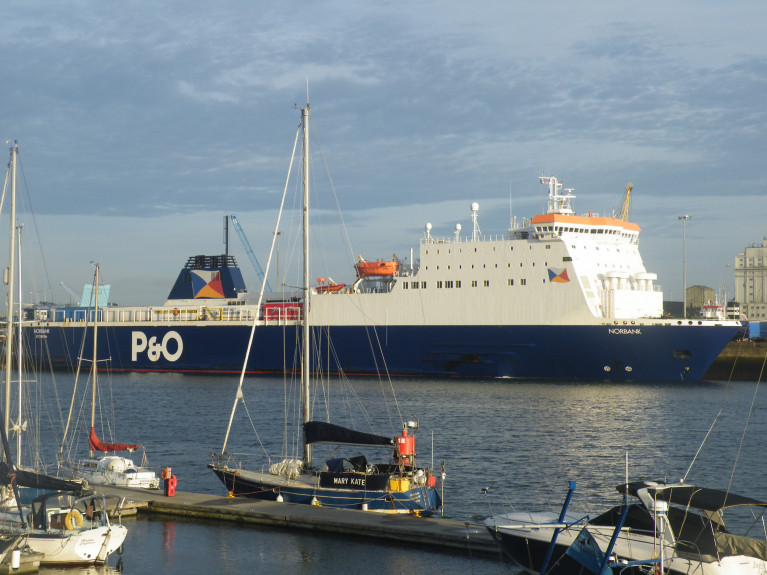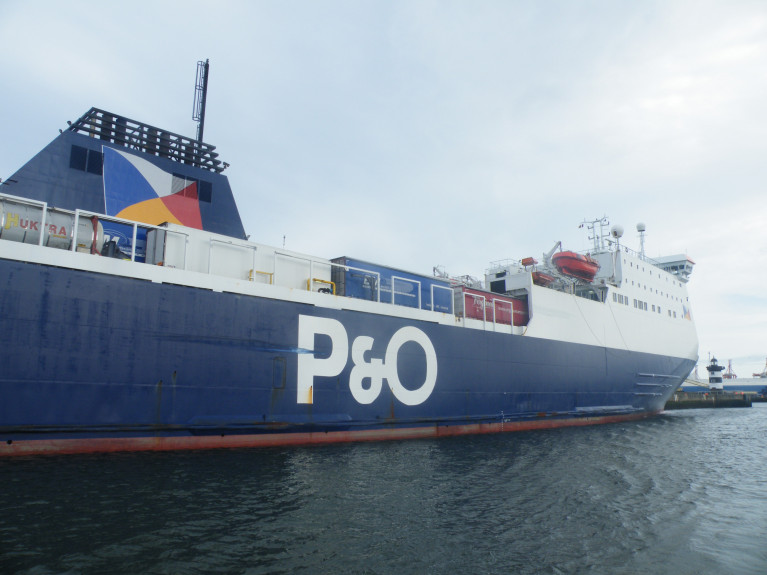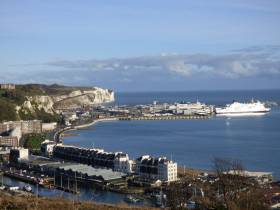Displaying items by tag: P&O Ferries
Stranded P&O Ferry in Liverpool Docks After Crew Member tests Positive for Covid-19
In the UK a P&O Ferries passenger/freight-ferry remains stranded at Liverpool Docks over the weekend after a crew member tested positive for coronavirus.
The Norbank, reports LiverpoolEcho, sailed into Seaforth (Dock) with passengers on Friday, but the vessel was taken out of service after the Covid-19 discovery was made.
The crew member was placed into self-isolation, but the development meant the ferry could not sail back to Ireland.
The Norbank was moved to a lay-by berth while the necessary health checks and precautions were carried out.
It remains at the Port of Liverpool still.
While one member of crew has tested positive for Covid-19, other crew were self-isolating and are being supported with tests and accommodation.
A spokesperson from P&O Ferries said: “The health and well-being of P&O Ferries’ passengers and crew is the company’s foremost priority.
"If any employee tests positive for Covid19, then the relevant authorities and employees are informed through the company’s robust internal procedures and to support UK track and trace systems.
"Last week, one member of crew on our Liverpool-Dublin route tested positive for Covid19 and is now self-isolating".
For further reading click here.
P&O Ferries Janette Bell, the Dover based chief executive officer who has just overseen a 1,100 redundancy scheme, is handing the reigns over to short routes managing director David Stretch who will become acting CEO.
Looking back over her three years in charge Ms bell told staff via email, according to KentOnLine.
She said: “It has been a privilege and a great challenge to lead this remarkable company for three years and I feel that now is the right time to hand over the reins to a new chief executive who can work with you to write the next chapter in our story.”
Having led P&O through the Brexit process to date and the Covid-19 pandemic, she has overseen significant transformational change.
The staff communication said this has put the company "in a strong position to thrive again going forward."
Mr Stretch will be at the helm until further notice.
Further reading of the story here.
In March Afloat reported P&O's announcement to furlough 1,100 staff on their key Dover-Calais route as it suspends passenger business – following a huge drop in demand due to the Covid-19 which led to focusing efforts on maintaining freight flows to and from the UK.
In addition to English Channel and North Sea services, P&O Ferries operate the Irish Sea route of Dublin-Liverpool and on the North Channel the Larne-Cairnryan link.
Finnish Island Based Operator's Ro-Ro Freight-Ferry Feeds into P&O's Dublin-Liverpool Service
A Finnish island based shipping operator has a ro-ro freighter on charter to P&O Ferries Dublin-Liverpool on the intensive central Irish Sea corridor link which currently only has one passenger ferry in service, writes Jehan Ashmore
Godby Shipping AB of Mariehamn, the capital of Åland Islands located in Baltic Sea between Finland and Sweden, has its ro-ro freight only Misida time-chartered to P&O. Misida brings a boost in capacity for 150 trailers (2,155 freight lane meters) throughout the decks of the 2007 built 14,100 gross tonnage ship.
Misida last month became the fourth ship to boost capacity having joined P&O's ropax sister's Norbank and Norbay in addition to another charter of Clipper Pennant from Seatruck Ferries. However, currently the service is reduced to three ships as Afloat reported the 125 freight-trailer / 114 passenger ropax Norbay is offservice from the Liffey-Merseyside link due to dry-docking on the opposite side of the England at the facility of A&P Tyne, near Newcastle on the North Sea.
In the meantime Misida operates Norbay's roster with the 22.50 arrivals (Mon-Fri) to Dublin Port and departures at 03.00 (Tue-Sat) for Liverpool on the 8 hour passage. This leaves only Norbank as the sole passenger carrying ship linking Ireland and Britain, though it should be note 'no' foot passengers are conveyed.
Misida however will only remain on the Irish Sea charter with P&O until this month as the ship along with sister Misana in October, have been chartered to Norwegian liner operator Sea-Cargo. The pair are Godby's largest ships out of seven-ship fleet are to be deployed between the Nordic nation and continental Europe.
So will P&O seek another replacement freighter when Misida is expected to leave the service this month?
The presence of Misida in the meantime on the Irish Sea recalls a fleetmate Mistal from last year's charter to P&O, though this freighter initially provided relief duties before taking over the roster of European Endeavour which was later sold to Scandinavian interests.
In disposing the largest ship on the Liverpool link last year, P&O Ferries passenger capacity was also reduced as European Endeavour carried 300 compared to 114 each of Norbank and Norbay. The pair were transferred from North Sea service in 2002 to the Irish Sea between Dublin and Gladstone Dock, Liverpool.
By coincidence the European Endeavour was sold to another Finnish operator, Ederi AB Eckerö and renamed Finbo Cargo. Despite as the name suggest, the ship also takes passengers on a Finland-Estonia no-frills route branded as 'Finbo Cargo by Eckerö Line' on the link connecting Helsinki (Vuosaari) to Tallinn (Muuga) where these outlying ports are located to the east of both Baltic capitals.
Eckerö Line also operate MS Finlandia (originally Moby Freedom from Italy) which offers a faster 'cruiseferry' based service directly connecting the ports of Helsinki and Tallinn.
Also currently operating in the Baltic is Mistral as Afloat tracked this morning (repositioning voyage?) between Kotka, Finland and Hirtshals, Denmark. The deployment of the freighter is understood to have only begun this month, though the charterer requested not to be known as outlined last month on Godby's website.
Previously, Mistral from the beginning of this year was chartered to Spanish ferry operator, Balearia on a mainland-Canary Islands service linking Huelva-Tenerife-Las Palmas.
Passenger Confusion as P&O 'Temporarily' Reinstate Route on North Sea Where Irish Sea Ferry Dry-Docks
A P&O Ferries ropax on the Dublin-Liverpool route, Afloat highlights, the Norbay is at A&P’s Tyne dry-dock facility at Hebburn near Newcastle on the North Sea where the 1992 built ferry first entered service until transferred a decade later onto the Irish Sea.
On a related note P&O's Hull-Zeebrugge route, reports Hull Live, of ferry passengers been left confused after the firm announced the Pride of Bruges cruise ferry would "temporarily" be back in service.
The ferry - which travels between Hull and Zeebrugge in Belgium - was "laid up" alongside the Pride of York, which sailed the same route when P&O Ferries suspended the service during lockdown.
However, the firm took to Facebook on Tuesday, August 4, to tell customers the ship was "back."
The post reads: "The Pride Of Bruges will be taking a limited amount of car passengers when she temporarily returns next week!"
Passengers assumed it meant the Hull to Zeebrugge route was back up and running, but questioned why it was only " temporary." Passengers have now called for clarity, but with no response from P&O. More here on the story.
For further information on P&O's North Sea route click the operator's sailing updates here in addition to the network of routes among the Irish Sea services of Dublin-Liverpool and Larne-Cairnryan.
Afloat adds while the Norbay remains off-service, sister Norbank is operating on the Liffey-Merseyside connection in addition two chartered-in freight-only ro-ro vessels. They are the Cypriot flagged Clipper Pennant and the more recently introduced Finnish flagged Misida.
Both these freighters can take a limited number of truck-drivers, whereas the Dutch built pair of Norbank and Norbay can also convey up to 114 passengers each but no foot customers.
Afloat this afternoon tracked the following P&O Ferrries vessels docked in Hull's King George V Dock, they are Pride of York and freightferry Norsky (out of service as Hull Live alluded). While outside the dock and berthed on the Humber Estuary is another much larger cruiseferry, Pride of Hull. A sister Pride of Rotterdam also links to mainland Europe.
Another Irish connection in north-west English port as Afloat reported yesterday was Dundalk Shipping's short-sea drycargo trader Huelin Dispatch which was underway from Middlesborough on the Tees river to Hull. This coastal passage took almost 14 hours to complete. The Irish flagged cargoship was built in The Netherlands, likewise of P&O's 'Nor' ropax pair were originally built for North Sea Ferries, hence the prefix given for their names.
Huelin Dispatch is also in the King George V Dock and among vessels including SMS Towage's Yorkshireman and Serviceman, fleetmates of the former Belfast Harbour serving Irishman which Afloat reported firstly in 2018.
The Japan built Irishman last month was tracked to south Wales at the Port of Barry where the tug currently remains on station.
Ferry Operator P&O Set to Loose 1,100 Jobs
Some 1,100 workers at P&O Ferries are to be made redundant as part of a plan to make the business “viable and sustainable”, the company said.
The proposal, reports the Irish Examiner, involves more than a quarter of the workforce losing their jobs.
A spokesman for P&O Ferries said: “Since the beginning of the crisis, P&O Ferries has been working with its stakeholders to address the impact of the loss of the passenger business.
“It is now clear that right-sizing the business is necessary to create a viable and sustainable P&O Ferries to get through Covid-19.
“Regrettably, therefore, due to the reduced number of vessels we are operating and the ongoing downturn in business, we are beginning consultation proceedings with a proposal to make around 1,100 of our colleagues redundant.”
Dubai based owner of P&O Ferries, reports BBC News, has said the UK government has been "slow" to react to the crisis facing vital supply routes.
The ferry company, which transports 15% of all goods in and out of the UK (incl Ireland), has applied for financial support to see it through the coronavirus lockdown.
The head of Dubai-based DP World told the BBC that P&O needs £257m in aid to avoid collapse and has applied to the UK government for £150m of that.
But Sultan Ahmed bin Sulayem said he has yet to get a response from the UK.
The DP World chairman and chief executive said: "P&O plays a vital role in the UK and thousands of jobs depend on this company. We have to be sure that when this is over we can bounce back and save these jobs.
"We have applied to the UK government to support the company to save the jobs of these people. The government has been slow. We need to safeguard these jobs - a lot of people's lives depends on this company."
As leisure passenger numbers have collapsed, moving freight only between the EU and the UK has become economically unviable. P&O has taken seven ships out of service (among them Pride of York according to the YorkshirePost).
As Afloat has previously reported P&O has also furloughed 1,400 workers, which will see the UK government paying 80% of their wages.
For further reading on the story click here.
In addition Afloat reported on the operator's Dublin-Liverpool ropax freight ferry Norbay which was detained in the UK port over port fees which was resolved recently.
The Norbank along with sister Norbay still retain their 'Nor' prefix named as a legacy of North Sea Ferries which as alluded in the photo caption above became part of the present P&O Ferries connecting the UK with Ireland and continental Europe.
P&O Detained Ferry Sets Sail after Furious £570,000 Liverpool Port Fees Row Resolved
A deadlock was today (yesterday) broken in a high-profile business bust-up which meant a detained ferry carrying key supplies back and forth across the Irish Sea (to Dublin Port) could leave Liverpool.
Top level talks have been ongoing since Thursday when the Liverpool Echo exclusively revealed how the Norbay, a P&O Ferries vessel was stranded in Seaforth.
It followed a dispute with Peel Ports, who own and administer the dock facilities of the Port of Liverpool, and who demanded a cheque for nearly £600,000 of what they claimed were outstanding fees.
P&O disagreed with that figure, believed it was two thirds that amount, and asked for flexibility to pay the bill at a time when they are losing many tens of thousands pounds a day in revenue due to the global pandemic lockdown.
The shipping company also added that their key contact at The Mersey Docks and Harbour Company had been furloughed without their knowledge, interrupting their communications.
Now, an agreement has been reached, allowing the Norbay to set sail for Ireland within the next few hours (last night), if necessary.
Afloat tracked this morning the Norbay which departed Dublin Port and is currently returning to Liverpool and from where Norbank is bound in the opposite direction.
Also tracked departing Dublin but on Sunday was the Norbank which arrived yesterday morning to the north Wales Port of Mostyn to carry out berthing trials as the Echo also reported that the company had hastily tried to pursue an alternative port.
At the Flintshire port was the pilot cutter Patrica in proximity of the ferry's berthing on the Dee Estuary where a predecessor P&O (Irish Sea) inaugurated a service to Dublin Port in 2002 but which only lasted for two years.
On the opposite side of the estuary is the Wirral Peninula in England and beyond the Mersey estuary where Norbay since Thursday of last week had remained detained in Liverpool until last night's sailing to the Irish capital.
Operator in Bid to Re-Route Ferries in Dublin Port Amid Row between P&O and the Port of Liverpool
Under way are efforts to re-route two P&O ferries stranded at Dublin Port amid an ongoing stand-off between the company and the Port of Liverpool.
As RTE News reports, the impasse arose on Thursday when Peel Ports, the owner of the Mersey Docks and Harbour Company, prevented a Dublin-bound P&O ferry (Norbay) leaving the Port of Liverpool over a £600,000 payment.
On this side of the Irish Sea, two freight ferries - one owned by P&O and the other chartered by the company - were unable to set sail for Liverpool because of the row.
The P&O-owned vessel in Dublin - the Norbank - was fully loaded and ready to depart when the incident unfolded in Liverpool.
It is understood negotiations took place between P&O and Dublin Port authorities through yesterday over the issue.
It is further understood P&O now intends to land the ferries at another port location in the north west of England and operate its Dublin service out of that facility until the situation at the Port of Liverpool is resolved.
To read more on this Irish Sea ferry development click here.
Operator P&O Ferries has announced “a significant strategic shift to reprioritise its efforts on its freight operations and maintain the flow of goods, including medical supplies, between the UK and Europe”.
The moves involve the ferry company “furloughing” 1,100 staff on the key Dover-Calais route as it suspends its passenger business – which has seen a huge drop in demand due to the Covid-19 pandemic – and focusing all of its efforts on maintaining the flow of freight to and from the UK.
Janette Bell, Chief Executive Officer of P&O Ferries, said: “Due to the outbreak of COVID-19, we are all grappling with an issue of enormous scale and human impact. P&O Ferries is having to respond with new measures to keep the business operational and to keep freight moving, which is vital to the economies of the United Kingdom, France, Ireland and the wider EU.
For more reports Lloyd's Loading List here.
On the Ireland-UK region, Afloat adds the operator has two routes: Dublin-Liverpool and Larne-Cairnryan in Scotland.
Operator P&O Ferries is seeking almost £33m in damages from the UK government over its handling of a challenge to ferry contracts under a no-deal Brexit.
The British-based shipping company, BBC reports, also wants courts to cancel the Department for Transport's settlement with Eurotunnel, and impose civil penalties.
In March, the DfT agreed to pay £33m to Eurotunnel, after the cross-channel operator sued for not being considered for a no-deal Brexit freight contract.
The DfT said it acted appropriately.
"This cross-government decision helped protect vital freight capacity for medical supplies to enter the country, in the event the UK left the EU without a deal," a spokesperson said.
As part of the agreement with Eurotunnel, the French company was mandated to spend £33m of taxpayers' money on improvements to the infrastructure of its terminal in Folkestone.
To read more including 'Mininum Disruption' at UK borders click here.


























